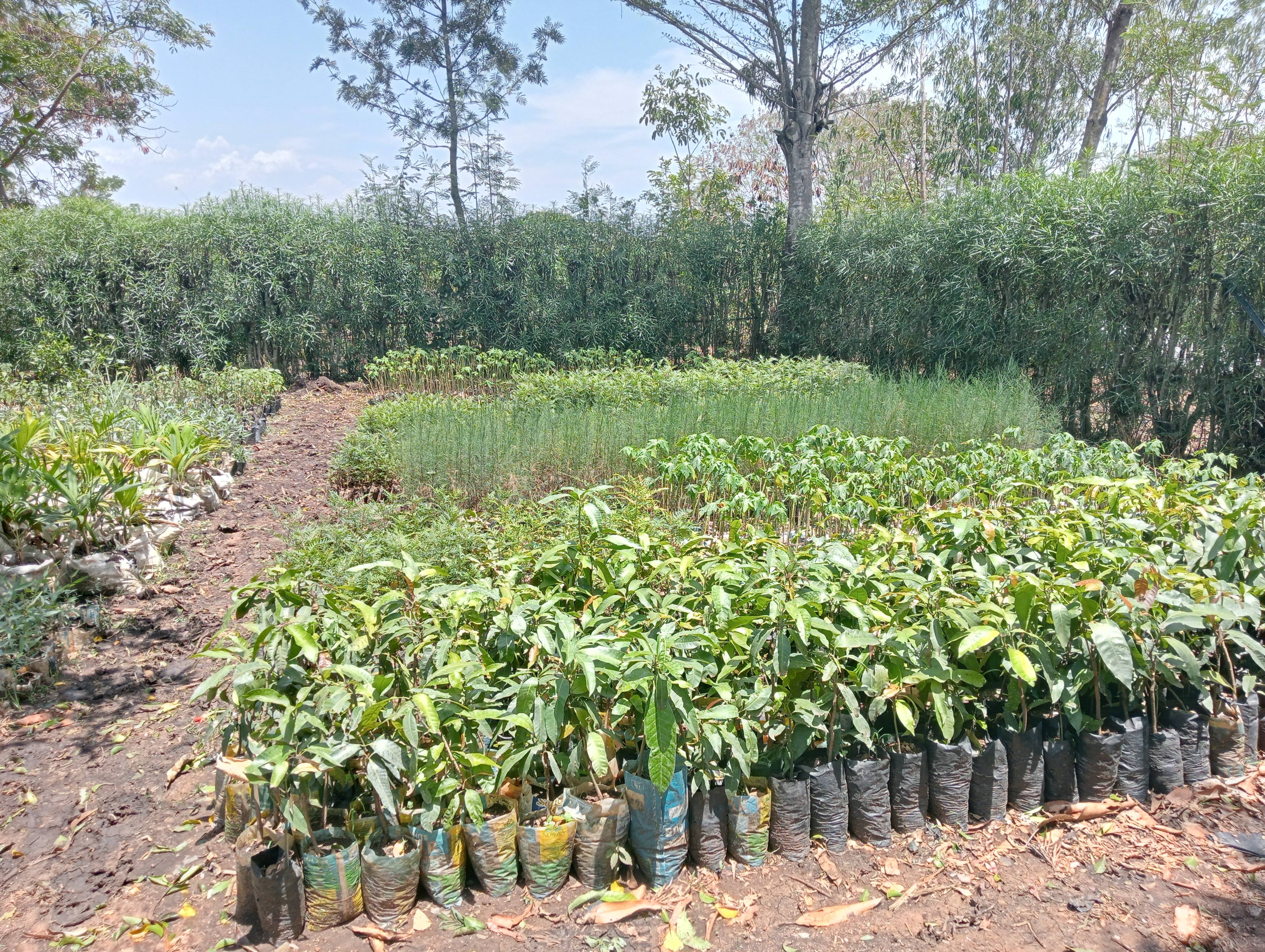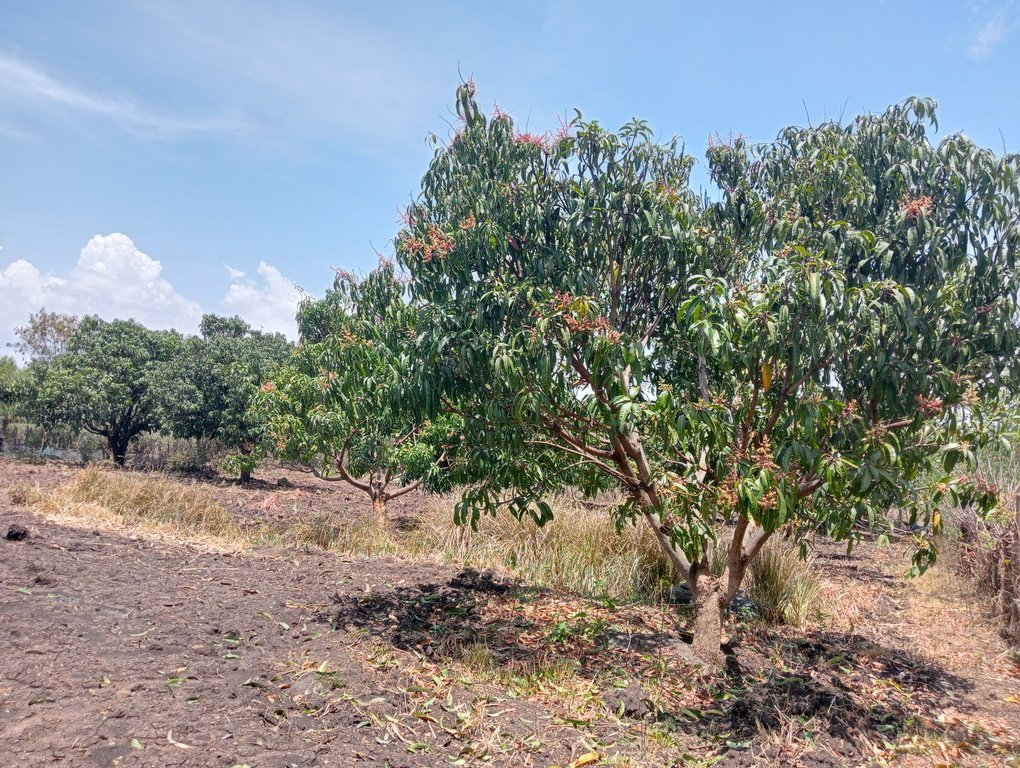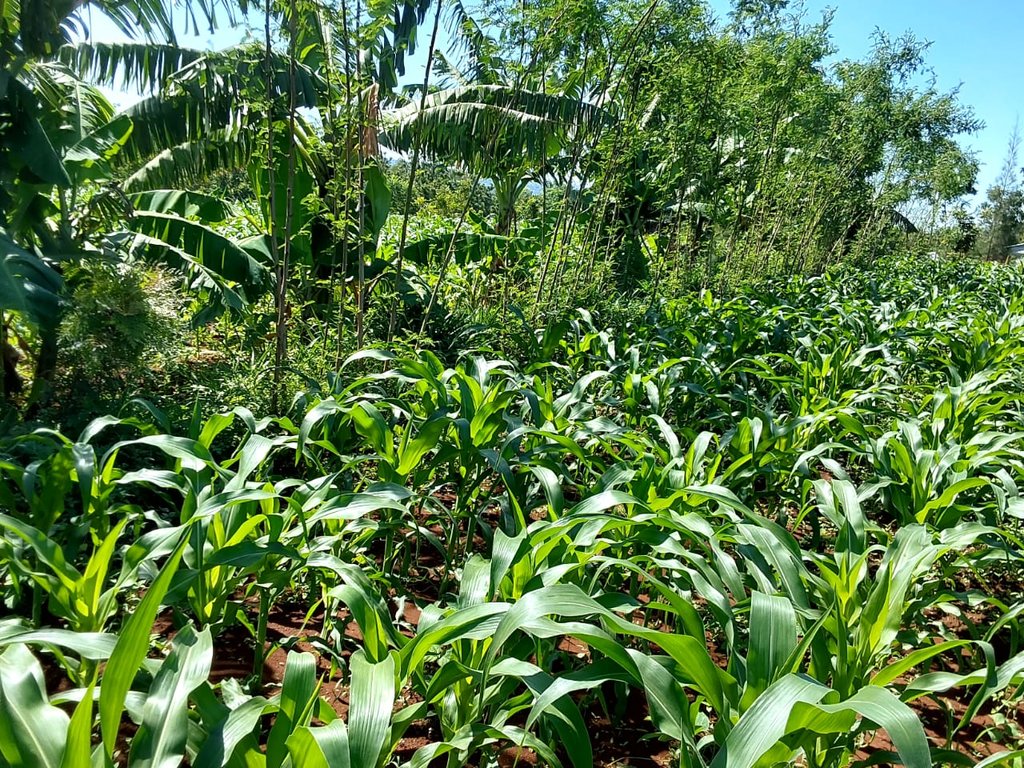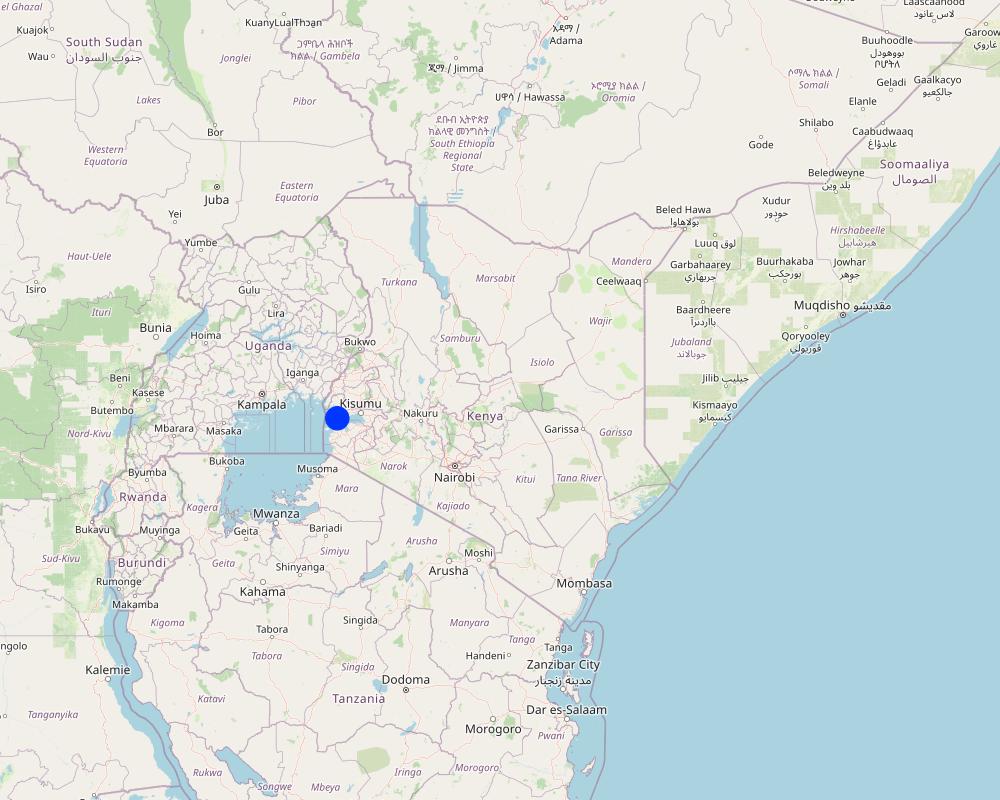Promotion of different trees for agroforestry [ប្រទេសកេនយ៉ា]
- ការបង្កើត៖
- បច្ចុប្បន្នភាព
- អ្នកចងក្រង៖ William Akwanyi
- អ្នកកែសម្រួល៖ JARED AYIENA, Innocent Faith, Noel Templer, JUSTINE OTSYULA, Tabitha Nekesa, Ahmadou Gaye, Siagbé Golli
- អ្នកត្រួតពិនិត្យច្រើនទៀត៖ William Critchley, Rima Mekdaschi Studer, Sally Bunning
approaches_6706 - ប្រទេសកេនយ៉ា
ពិនិត្យមើលគ្រប់ផ្នែក
ពង្រីកមើលទាំងអស់ បង្រួមទាំងអស់1. ព័ត៌មានទូទៅ
1.2 ព័ត៌មានលម្អិតពីបុគ្គលសំខាន់ៗ និងស្ថាប័នដែលចូលរួមក្នុងការវាយតម្លៃ និងចងក្រងឯកសារនៃវិធីសាស្ត្រផ្សព្វផ្សាយ
បុគ្គលសំខាន់ម្នាក់ (ច្រើននាក់)
អ្នកប្រើប្រាស់ដី:
Omolo Charles Abok
+254 728 135152
charlesabok88@gmail.com
Welthungerhilfe farmer
Village of Nyaguda, South Sakwa ward, Bondo Sub-county, Siaya County
ប្រទេសកេនយ៉ា
អ្នកជំនាញឯកទេស SLM:
អ្នកជំនាញឯកទេស SLM:
ឈ្មោះគម្រោងដែលបានចងក្រងឯកសារ/ វាយតម្លៃលើវិធីសាស្ត្រផ្សព្វផ្សាយ (បើទាក់ទង)
Soil protection and rehabilitation for food security (ProSo(i)l)ឈ្មោះអង្គភាពមួយ (ច្រើន) ដែលបានចងក្រងឯកសារ/ វាយតម្លៃលើវិធីសាស្ត្រផ្សព្វផ្សាយ (បើទាក់ទង)
Deutsche Gesellschaft für Internationale Zusammenarbeit (GIZ)ឈ្មោះអង្គភាពមួយ (ច្រើន) ដែលបានចងក្រងឯកសារ/ វាយតម្លៃលើវិធីសាស្ត្រផ្សព្វផ្សាយ (បើទាក់ទង)
Alliance Bioversity and International Center for Tropical Agriculture (Alliance Bioversity-CIAT) - ប្រទេសកេនយ៉ា1.3 លក្ខខណ្ឌទាក់ទងទៅនឹងការប្រើប្រាស់ទិន្នន័យដែលបានចងក្រងតាមរយៈវ៉ូខេត
តើពេលណាដែលទិន្នន័យបានចងក្រង (នៅទីវាល)?
01/03/2023
អ្នកចងក្រង និង(បុគ្គលសំខាន់ៗ)យល់ព្រមទទួលយកនូវលក្ខខណ្ឌនានាទាក់ទងទៅនឹងការប្រើប្រាស់ទិន្នន័យដែលបានចងក្រងតាមរយៈ វ៉ូខេត:
បាទ/ចា៎
1.4 ការយោងមួយ (ច្រើន) ទៅលើ (កម្រង) បញ្ជីសំណួរនៃបច្ចេកទេស SLM
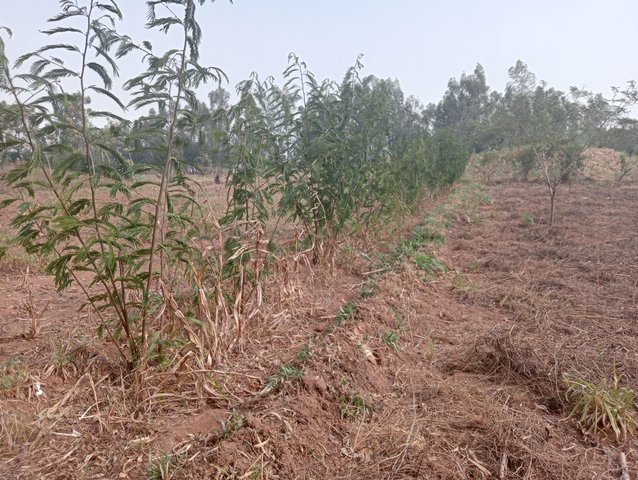
Vegetative cross-slope barriers [ប្រទេសកេនយ៉ា]
Cross-slope barriers in the form of vegetative strips are established on sloping lands to reduce runoff velocity and prevent soil loss, thereby contributing to the conservation of soil, water, and plant nutrients.
- អ្នកចងក្រង៖ William Akwanyi
2. ការពណ៌នាអំពីវិធីសាស្ត្រផ្សព្វផ្សាយ SLM
2.1 ពណ៌នាសង្ខេបខ្លីពីវិធីសាស្ត្រផ្សព្វផ្សាយ
Promoting the values of different trees and their benefits in agroforestry contributes to increased adoption by farmers.
2.2 ពណ៌នាលម្អិតពិវិធីសាស្ត្រផ្សព្វផ្សាយ
ពណ៌នាលម្អិតពិវិធីសាស្ត្រផ្សព្វផ្សាយ:
Agroforestry involves the integration of trees and/ or shrubs in a farming system on the same land where crops or pastures are grown. It offers significant environmental, economic, and social benefits. Agroforestry also enables farmers to diversify their on-farm income. Furthermore, it contributes to climate change adaptation and mitigation and improves the environment within the farm, especially soils. However, not every farmer is willing to adopt agroforestry. Trees and shrubs take up space that would have been dedicated to crops or pasture: this is a primary reason why farmers are not willing to plant trees and/ or shrubs on their farms. Similarly, many farmers do not clearly understand the values of some trees and shrubs. It is, therefore, essential to overcome the barriers to adopting agroforestry among farmers.
The ProSoil project has created awareness among farmers in Kakamega, Bungoma, and Siaya Counties about the more efficient and profitable tree and shrub-based value chains to attract farmers to agroforestry and pave the way for greater uptake. The farmers were targeted through their groups. Each group consisting of about 25 farmers, and with at least 30% women. Farmers are introduced to trees and/ or shrubs that blend well with their farming system. In addition, farmers choose trees and/ or shrubs based on the sizes of their farming land and their respective benefits. Farmers can plant trees and shrubs as single stands or integrate them into farming land. They can also plant agroforestry trees around their homesteads. A single stand can have, for example, mangos, avocados, and/or other trees. The project advocates for a more sustainable win-win approach where farmers and the environment benefit from an agroforestry system. Some of the benefits of trees and shrubs, as highlighted by the project, include the following:
a) Soil erosion control: trees and shrubs are planted on across slopes to slow down runoff and trap sediment (consequently, accumulating soil – this can form terraces after several years). Their roots hold the soil in place and reduce the impact of moving water.
b) Stabilising stream banks and gullies (e.g., Leucaena leucocephala, Sesbania grandiflora, Moringa oleifera, etc.): help to reduce soil erosion along streams and gullies when planted at the medium- to high-level watermark. Their roots hold the soil in place and reduce the impact of moving water.
c) Green manure (e.g., Sesbania sesban, Tithonia sp., etc.): from foliage and twigs.
d) Live fences (e.g., Tithonia sp.): used as boundaries to provide privacy and protection from browsing animals.
e) Windbreakers (e.g., Casuarina equisetifolia, Grevillea robusta, Leucaena leucocephala, etc.): planted in one or two rows/ lines closely together along the edges of the farm and perpendicular to winds to protect crops, soils, and structures from the detrimental effects of wind.
f) Fodder (e.g., Grevillea robusta, Sesbania sesban, Leucaena leucocephala, etc.): foliage is food for livestock.
g) Food (e.g., mangoes, avocadoes, etc.): a human food source.
h) Carbon sequestration (all trees and shrubs): they act as carbon sinks by capturing carbon dioxide from the atmosphere.
2.3 រូបភាពនៃវិធីសាស្ត្រផ្សព្វផ្សាយ
2.5 ប្រទេស/តំបន់/ទីតាំងកន្លែង ដែលវិធីសាស្ត្រផ្សព្វផ្សាយត្រូវបានអនុវត្តន៍
ប្រទេស:
ប្រទេសកេនយ៉ា
តំបន់/រដ្ឋ/ខេត្ត:
Siaya County, Nyanza Region
បញ្ជាក់បន្ថែមពីលក្ខណៈនៃទីតាំង:
Nyagudha village, South Sakwa Ward, Bondo Sub-county
Map
×2.6 កាលបរិច្ឆេទនៃការចាប់ផ្តើម និងបញ្ចប់នៃវិធីសាស្រ្តផ្សព្វផ្សាយនេះ
សូមបញ្ជាក់ឆ្នាំដែលបានបង្កើតឡើង:
2019
2.7 ប្រភេទនៃវិធីសាស្ត្រផ្សព្វផ្សាយ
- Both traditional practice and project based: farmers have been growing trees and shrubs on their farms but the ProSoil project introduced them to more beneficial trees and better ways of producing the trees e.g., through grafting.
2.8 គោលបំណង/ទិសដៅសំខាន់នៃវិធីសាស្ត្រផ្សព្វផ្សាយ
Aim: To promote the adoption of agroforestry.
Objectives:
1) To introduce farmers to the diverse benefits of trees in farming.
2) To encourage farmers to incorporate trees and/ or shrubs in their farming.
2.9 លក្ខខណ្ឌអនុញ្ញាត ឬរារាំងការអនុវត្តន៍បច្ចេកទេសដែលស្ថិតនៅក្រោមវិធីសាស្រ្តផ្សព្វផ្សាយ
សង្គម/វប្បធម៌/ និងតម្លៃនៃសាសនា
- អំណោយផល
Trees play a central role in the socio-cultural lives of people and are used for a wide range of cultural practices.
- រារាំង
Cultural beliefs: e.g., women are not supposed to plant (some) trees as this is considered a male role. This hinders women from full participation in agroforestry activities.
ភាពអាចរកបាននៃធនធានហិរញ្ញវត្ថុ និងសេវាកម្ម
- រារាំង
Some farmers do not have adequate financial resources to purchase seedling of some tree and shrub seedlings.
ការសហការ/ការសម្របសម្រួលតួអង្គពាក់ព័ន្ធ
- អំណោយផល
Other institutions such as the county governments pass agroforestry information to farmers through the public agricultural extension officers. County governments are important collaborators in the ProSoil project.
ក្របខណ្ឌច្បាប់ (សិទ្ធិកាន់កាប់ដីធ្លី កម្មសិទ្ធីប្រើប្រាស់ដីនិងទឹក)
- រារាំង
Trees and/ or shrubs take several years to mature. This is closely linked to land tenure since most people would prefer to establish trees only on their farms.
គោលនយោបាយ
- អំណោយផល
Kenya's 10 Percent Tree Cover Strategy includes the component of promoting farm forestry through various platforms e.g., radio and TV.
អភិបាលកិច្ចដី (ការសម្រេចចិត្ត ការអនុវត្ត និងការរឹតបន្តឹង)
- រារាំង
Women and youth have little or no control over land in most communities. Hence, they cannot make decisions to plant (some) trees on the family land.
ចំណេះដឹងស្តីពី SLM និងការទទួលបានការគាំទ្រផ្នែកបច្ចេកទេស
- អំណោយផល
ProSoil project has supported the dissemination of information about the importance of agroforestry as an SLM technology and how to propagate trees e.g., through grafting. As a result, some farmers have established trees nurseries.
ទីផ្សារ (ទិញធាតុចូល លក់ផលិតផល) និងតម្លៃ
- អំណោយផល
The increasing awareness about the benefits of many trees has led to an increase in the demand for the different products from the trees e.g., fruits, honey, medicines, etc. This potential of trees to generate income encourages farmers to plant trees.
3. ការចូលរួម និងតួនាទីរបស់ភាគីពាក់ព័ន្ធ
3.1 អ្នកពាក់ព័ន្ធដែលបានចូលរួមក្នុងវិធីសាស្ត្រផ្សព្វផ្សាយ និងតួនាទីរបស់ពួកគេ
- អ្នកប្រើប្រាស់ដីក្នុងតំបន់/សហគមន៍
Farmers, farmer groups (women, youth, and mixed gender)
Recipients of the trainings in agroforestry.
- អ្នកឯកទេសគ្រប់គ្រងដីប្រកបដោយចីរភាព/ទីប្រឹក្សាបច្ចេកទេសកសិកម្ម
GIZ ProSoil project SLM specialists; specialists from the implementing partner, Welthungerhilfe; and county SLM specialists from the departments of agriculture and environment.
Provides technical advice to the farmers and link farmers to markets and tree nurseries.
- រដ្ឋាភិបាលថ្នាក់មូលដ្ឋាន
County government agriculture and environment departments
Provides technical advice to the farmers and link farmers to markets and tree nurseries.
- អង្គការអន្តរជាតិ
GIZ
Financial support to the technical team and farmers during capacity building.
ប្រសិនមានភាគីពាក់ព័ន្ធច្រើនចូលរួមសូមចង្អុលបង្ហាញភ្នាក់ងារដែលនាំមុខគេ:
GIZ
3.2 ការចូលរួមរបស់អ្នកប្រើប្រាស់ដីក្នុងតំបន់/ សហគមន៍ក្នុងតំបន់ក្នុងដំណាក់កាលផ្សេងគ្នានៃវិធីសាស្រ្តផ្សព្វផ្សាយ
| ការចូលរួមរបស់អ្នកប្រើប្រាស់ដីក្នុងតំបន់/សហគមន៍ក្នុងតំបន់ | សូមបញ្ជាក់នរណាត្រូវបានចូលរួម ព្រមទាំងពណ៌នាសកម្មភាពទាំងនោះ | |
|---|---|---|
| ការចាប់ផ្តើម/ការលើកទឹកចិត្ត | គំនិតផ្តួចផ្តើមដោយខ្ឡួនឯង | Farmers involved in the training in agroforestry. |
| ការរៀបចំផែនការ | អន្តរកម្ម | Farmers consulted on where and when to establish demos of agroforestry tree nurseries. |
| ការអនុវត្តន៍ | គំនិតផ្តួចផ្តើមដោយខ្ឡួនឯង | Although farmers are advised which trees are better for their farms, they are the final decision makers on which trees and shrubs to incorporate in their farms. |
| ការត្រួតពិនិត្យ និងវាយតម្លៃ | អសកម្ម | Interviews with implementing farmers. |
| គ្មាន |
3.3 គំនូសបំព្រួញ (ប្រសិនបើមាន)
ការពណ៌នា:
The ProSoil project (GIZ and WHH) provides financial (transport reimbursement) and material (seedlings) support to farmers through their groups (Ndati Development Self-Help Group). The project also facilitates the county departments of Agriculture and Environment to train farmers in agroforestry and increase their awareness about the socio-economic and ecological benefits of different trees. at the farm.
អ្នកនិពន្ធ:
William Akwanyi
3.4 ការសម្រេចចិត្តលើការជ្រើសរើសបច្ចេកទេស SLM
សូមបញ្ជាក់តើអ្នកណាជាអ្នកបានសម្រេចចិត្តក្នុងការជ្រើសរើសបច្ចេកទេសដើម្បីយកមកអនុវត្តន៍:
- អ្នកប្រើប្រាស់ដី ដោយមានការគាំទ្រពីអ្នកជំនាញឯកទេស SLM
ចូរពន្យល់:
The ProSoil project team provides technical support on the selection of trees based on the diverse needs of farmers, and the sizes and locations of their farms. However, the final decision to plant which type(s) of trees and where to plant them at the farm rests with the farmer.
សូមបញ្ជាក់ តើការសម្រេចធ្វើឡើងដោយផ្អែកលើអ្វីជាមូលដ្ឋាន:
- វាយតម្លៃទៅលើចំណេះដឹងស្តីអំពី SLM ដែលបានចងក្រងជាឯកសារបានត្រឹមត្រូវ (ផ្អែកលើភស្តុតាងជាមូលដ្ឋានដើម្បីសម្រេចចិត្ត)
- បទពិសោធន៍ និងគំនិតផ្ទាល់ខ្លួន(ពុំមានចងក្រងជាឯកសារ)
4. ជំនួយបច្ចេកទេស ការកសាងសមត្ថភាព និងការគ្រប់គ្រងចំណេះដឹង
4.1 ការកសាងសមត្ថភាព/ បណ្តុះបណ្តាល
តើវគ្គបណ្តុះបណ្តាលបានផ្តល់ឱ្យអ្នកប្រើប្រាស់ដី/អ្នកពាក់ព័ន្ធផ្សេងៗទៀតដែរឬទេ?
បាទ/ចា៎
សូមបញ្ជាក់តើអ្នកណាត្រូវបានបណ្តុះបណ្តាល:
- អ្នកប្រើប្រាស់ដី
ទម្រង់នៃការបណ្តុះបណ្តាល:
- ពីកសិករទីកសិករ
- ទីតាំងបង្ហាញ
ប្រធានបទបណ្តុះបណ្តាល:
1. Different trees in agroforestry and their benefits
2. Tree nursery management
3. Grafting
4. Agroforestry systems
5. Value addition to agroforestry products and marketing
មតិយោបល់:
Welthungerhilfe contracted SLM specialists from the county departments of agriculture and environment to train farmers and carry out demonstrations on tree planting and value addition in their groups during sessions organized by the ProSoil project. Other farmers are learning from the trained farmers. These specialists also advice farmers during farm visits.
4.2 សេវាផ្តល់ប្រឹក្សាយោបល់
តើអ្នកប្រើប្រាស់ដីបានទទួលនូវសេវាផ្តល់ប្រឹក្សាដែរ ឬទេ?
បាទ/ចា៎
សូមបញ្ជាក់ប្រសិនបើសេវាកម្មប្រឹក្សាយោបល់ត្រូវបានផ្តល់ឱ្យ:
- នៅលើដីរបស់អ្នកប្រើប្រាស់ដី
- នៅមជ្ឈមណ្ឌលជាអចិន្ត្រៃ
- Specific locations where the farmers interact with the technical officers and at their farms.
ពណ៌នា/ពន្យល់:
Farmers were trained in their groups at specific venues during sessions organized by the ProSoil project/ WHH. Other farmers are learning from the trained farmers. These specialists also advice farmers during farm visits.
4.3 ការពង្រឹងសមត្ថភាពស្ថាប័ន (ការអភិរឌ្ឍន៍អង្គភាព)
តើស្ថាប័នទាំងអស់ត្រូវបានបង្កើតឡើង ឬពង្រឹងសមត្ថភាពតាមរយៈវិធីសាស្ត្រផ្សព្វផ្សាយដែរ ឬទេ?
- បាទ/ច៎ា តិចតួច
សូមបញ្ជាក់ថាតើស្ថាប័នត្រូវបានពង្រឹង ឬបង្កើតឡើងនៅត្រឹមកម្រិតណា(ច្រើន)?
- ថ្នាក់មូលដ្ឋាន
ចូពណ៌នាពីស្ថាប័ន តួនាទី និងទំនួលខុសត្រូវ សមាជិក ។ល។:
Farmers have formed groups such as Ndati Development Self-Help Group e.g., to run tree nurseries. The groups consist of several men and women of diverse ages. Farmers develop funding and other support proposals through the groups.
សូមបញ្ជាក់ប្រភេទនៃការគាំទ្រ:
- ការកសាងសមត្ថភាព/ បណ្តុះបណ្តាល
- សម្ភារៈ
សូមផ្តល់ព័ត៌មានបន្ថែមទៀតឱ្យបានលម្អិត:
Trainings in agroforestry, markets, tree propagation, etc.
Nursery materials and equipment including water tanks, seeds and grafting tools
4.4 ការត្រួតពិនិត្យ និងវាយតម្លៃ
តើការត្រួតពិនិត្យ និងវាយតម្លៃគឺជាផ្នែកមួយនៃវិធីសាស្ត្រដែរឬទេ?
បាទ/ចា៎
មតិយោបល់:
GIZ and Welthungerhilfe regularly follows up with farmers to check on the implementation of technologies promoted under this approach.
ប្រសិន បាទ/ច៎ា តើឯកសារនេះបានបង្កើតឡើងក្នុងគោលបំណងប្រើប្រាស់សម្រាប់ការត្រួតពិនិត្យ និងវាយតម្លៃដែរឬទេ?
ទេ
មតិយោបល់:
This documentation in intended for keeping a record of SLM technologies and approaches.
4.5 ការស្រាវជ្រាវ
តើការស្រាវជ្រាវ គឺជាផ្នែកមួយនៃវិធីសាស្រ្តដែរឬទេ?
ទេ
5. ថវិកា និងសម្ភារៈឧបត្ថម្ភពីខាងក្រៅ
5.1 ថវិកាប្រចាំឆ្នាំសម្រាប់ផ្សព្វផ្សាយ SLM
ប្រសិនបើចំនួនពិតប្រាកដនៃថវិកាប្រចាំឆ្នាំមិនត្រូវបានដឹងច្បាស់ សូមប្រាប់ពីចន្លោះនៃថវិកានោះ:
- 10,000-100,000
មតិយោបល់ (ឧ. ប្រភពសំខាន់នៃមូលនិធិ/ម្ចាស់ជំនួយចំបង):
ProSoil project facilitated trainings on the SLM technologies under this approach, including transport reimbursement to farmers and trainers and remuneration to trainers during trainings. Farmers meet the costs of land preparation, acquiring seeds and seedlings, planting trees, and managing the trees. The stated budget is for training one farmer group of about 25 farmers.
5.2 ការគាំទ្រផ្នែកហិរញ្ញវត្ថុ / សម្ភារៈដែលបានផ្តល់ទៅឱ្យអ្នកប្រើប្រាស់ដី
តើអ្នកប្រើប្រាស់ដីបានទទួលការគាំទ្រផ្នែកហិរញ្ញវត្ថ/សម្ភារៈសម្រាប់ការអនុវត្តន៍បច្ចេកទេសដែរឬទេ:
បាទ/ចា៎
ប្រសិនបាទ/ច៎ា សូមបញ្ជាក់ប្រភេទ(ច្រើន)នៃការគាំទ្រ លក្ខខណ្ឌ និងអ្នកផ្តល់ឱ្យ(ច្រើន):
The ProSoil project through Welthungerhilfe supported the farmers (through their group) with trainings and setting up demo plots.
5.3 សូមបញ្ជាក់ពីធាតុចូលត្រូវបានផ្តល់បដិភាគ (រួមទាំងកម្លាំងពលកម្ម)
- គ្មាន
ប្រសិនបើកម្លាំងពលកម្មធ្វើដោយអ្នកប្រើប្រាស់ដី តើវាជាធាតុចូលដ៏សំខាន់មួយដែរ ឬទេ:
- ដោយស្ម័គ្រចិត្ត
មតិយោបល់:
Farmers voluntarily provided labour at the demonstration plot and on their own land.
5.4 ឥណទាន
តើឥណទានដែលបានផ្តល់នៅក្រោមវិធីសាស្ត្រផ្សព្វផ្សាយសម្រាប់សកម្មភាព SLM នេះយ៉ាងដូចម្តេច?
ទេ
5.5 ការលើកទឹកចិត្ត ឬវិធីសាស្ត្រដ៏ទៃទៀត
តើមានការលើកទឹកចិត្តផ្សេងទៀត ឬឧបករណ៍ប្រើប្រាស់ដើម្បីលើកកម្ពស់ការអនុវត្តន៍បច្ចេកទេស SLM?
បាទ/ចា៎
បើបាទ/ចា៎ សូមបញ្ជាក់:
Linkage to markets for the tree and shrub products. GIZ, WHH, and the county department of agriculture and environmental invite farmers to field days where the farmer can link up with potential markets.
6. ការវិភាគរកផលប៉ះពាល់ និងសេចក្តីសន្និដ្ឋាន
6.1 ផលប៉ះពាល់នៃវិធីសាស្ត្រផ្សព្វផ្សាយ
តើវិធីសាស្ត្រផ្សព្វផ្សាយបានផ្តល់សិទ្ធិអំណាចដល់អ្នកប្រើប្រាស់ដី ធ្វើឱ្យប្រសើរឡើងនូវការចួលរួមអ្នកពាក់ព័ន្ធ?
- ទេ
- បាទ/ច៎ា បន្តិចបន្តួច
- បាទ/ច៎ា ជាមធ្យម
- បាទ/ច៎ា បានខ្លាំង
Farmers were empowered with skill on how to propagate trees. Stakeholder participation was enhanced through collaboration with other actors such as the county government.
តើវិធីសាស្រ្តផ្សព្វផ្សាយនេះអនុញ្ញាតឱ្យធ្វើការសម្រេចចិត្ដដោយផ្អែកលើភស្តុតាងជាមូលដ្ឋានដែរ ឬទេ?
- ទេ
- បាទ/ច៎ា បន្តិចបន្តួច
- បាទ/ច៎ា ជាមធ្យម
- បាទ/ច៎ា បានខ្លាំង
Farmers were motivated to plant some trees and shrubs on their farms after benchmarking farms which had established and benefited from similar trees.
តើវិធីសាស្ត្រផ្សព្វផ្សាយជួយអ្នកប្រើប្រាស់ដីដើម្បីអនុវត្តន៍ និងថែទាំបច្ចេកទេស SLM?
- ទេ
- បាទ/ច៎ា បន្តិចបន្តួច
- បាទ/ច៎ា ជាមធ្យម
- បាទ/ច៎ា បានខ្លាំង
After learning about the importance of different trees, farmers incorporated trees in their farming systems e.g., planting trees and/ or shrubs in vegetative cross slope barriers.
តើវិធីសាស្ត្រផ្សព្វផ្សាយនេះធ្វើឱ្យចំណេះដឹងប្រសើឡើង និងសមត្ថភាពរបស់អ្នកប្រើប្រាស់ដីក្នុងការអនុវត្តន៏ SLM?
- ទេ
- បាទ/ច៎ា បន្តិចបន្តួច
- បាទ/ច៎ា ជាមធ្យម
- បាទ/ច៎ា បានខ្លាំង
The trainings given to farmers included how to plant different trees and areas within a farm setting where such trees are best suited. This knowledge was helpful in the incorporation of trees in the implementation of vegetative cross-slope barriers, green manure cover crops, and retention ditches.
តើវីធីសាស្ត្រផ្សព្វផ្សាយនេះបានកាត់បន្ថយជំលោះឬទេ?
- ទេ
- បាទ/ច៎ា បន្តិចបន្តួច
- បាទ/ច៎ា ជាមធ្យម
- បាទ/ច៎ា បានខ្លាំង
Planting of quick growing shrubs has provided source of fuel wood at the household level reducing conflicts resulting in neighbouring farmers invading farms for fuel wood
តើវិធីសាស្ត្រផ្សព្វផ្សាយនាំឱ្យប្រសើរឡើងនូវសន្តិសុខស្បៀង/ធ្វើឱ្យប្រសើរឡើងនូវអាហាររូបត្ថម្ភ?
- ទេ
- បាទ/ច៎ា បន្តិចបន្តួច
- បាទ/ច៎ា ជាមធ្យម
- បាទ/ច៎ា បានខ្លាំង
Some of the agroforestry trees promoted under the different technologies and for which this approach sought to create awareness about are sources of food.
តើវិធីសាស្ត្រផ្សព្វផ្សាយធ្វើឱ្យប្រើសើរឡើងនូវការស្វែងរកទីផ្សារ?
- ទេ
- បាទ/ច៎ា បន្តិចបន្តួច
- បាទ/ច៎ា ជាមធ្យម
- បាទ/ច៎ា បានខ្លាំង
The trainings include linking farmers to market for some of the agroforestry products.
តើវិធីសាស្ត្របានធ្វើឱ្យប្រសើរឡើងនូវការកសាងសមត្ថភាពរបស់អ្នកប្រើប្រាស់ដីដើម្បីបន្សុំាទៅនឹងការប្រែប្រួលអាកាសធាតុ/អាកាសធាតុក្តៅហែង និងកាត់បន្ថាយគ្រោះមហន្តរាយទាក់ទឹងនឹងអាកាសធាតុ?
- ទេ
- បាទ/ច៎ា បន្តិចបន្តួច
- បាទ/ច៎ា ជាមធ្យម
- បាទ/ច៎ា បានខ្លាំង
Some of the trees are sources of food during months when there is scarcity of food e.g., mangoes mature mostly during the dry season when there is scarcity of food in the households.
តើវិធីសាស្ត្រផ្សព្វផ្សាយនេះនាំឱ្យមានការងារ ឱកាសរកប្រាក់ចំណូល?
- ទេ
- បាទ/ច៎ា បន្តិចបន្តួច
- បាទ/ច៎ា ជាមធ្យម
- បាទ/ច៎ា បានខ្លាំង
Some farmers have established tree nurseries. They sell tree seedlings to earn income. Some have employed tree nursery operators.
6.2 ការលើកទឹកចិត្តចម្បងៗរបស់អ្នកប្រើប្រាស់ដីសម្រាប់ការអនុវត្តបច្ចេកទេស SLM
- បង្កើនផលិតកម្ម
Some of the trees and shrubs promoted e.g., sesbania improve soil through nitrogen fixation. Hence, they increase soil productivity and consequently crop and livestock production.
- បង្កើនប្រាក់ចំណេញ (សមត្ថភាព) បង្កើនអត្រាចំណេញ
Most trees do not require costly implementation activities, yet they have multiple uses at the farm, including sources of products e.g., fruits that can be sold to earn income. This increased the profitability of the farm. This reduces the costs incurred at the farm against the benefits accrued.
- ការកាត់បន្ថយការធ្លាក់ចុះគុណភាពដី
Trees reduce soil erosion and formation of gullies. They also add nutrients to the soil.
- កាត់បន្ថយហានិភ័យនៃគ្រោះមហន្តរាយ
Trees reduce the flow of runoff and increase the infiltration of water into the soil. Such water would have otherwise caused flooding downstream. they also act as windbreakers reducing damage on farms.
- ពង្រឹងស្មារតីផ្នែកបរិស្ថាន
Farmers understand the importance of trees in environmental management. They have planted trees - trees conserve the environment.
- លើកកម្ពស់ចំណេះដឹង និងជំនាញ SLM
Farmers have enhanced their knowledge in agroforestry, including tree nursery management. They also capacity build other farmers.
- ការកែលម្អសោភ័ណ្ឌភាព
Farmers have planted trees that have beautified their homes and farms.
6.3 សកម្មភាពផ្សព្វផ្សាយដែលប្រកបដោយចីរភាព
តើអ្នកប្រើប្រាស់ដីអាចធ្វើឱ្យមានចីរភាពនូវអ្វីដែលត្រូវបានអនុវត្តន៍តាមរយៈវិធីសាស្ត្រផ្សព្វផ្សាយដែរឬទេ(ដោយពុំមានការគាំទ្រពីអ្នកខាងក្រៅ)?
- បាទ/ចា៎
ប្រសិនបាទ/ច៎ា សូមរៀបរាប់ថាធ្វើយ៉ាងម៉េច:
Farmers have established group tree nurseries as sources of seedlings and income. Some of the trees promoted under this approach can easily be propagated by farmers.
6.4 ភាពខ្លាំង/ គុណសម្បត្តិនៃវិធីសាស្ត្រផ្សព្វផ្សាយ
| ភាពខ្លាំង/ គុណសម្បត្តិ/ ឱកាស ទស្សនៈរបស់អ្នកប្រើប្រាស់ដី |
|---|
| Trees contribute to environmental management - increase in carbon sequestration (capture of carbon dioxide), control of soil erosion, and conservation of water. |
| Trees have multiple products, including food, humus, timber, firewood, etc. |
| Most trees do not require costly and tedious maintenance. |
| ភាពខ្លាំង/ គុណសម្បត្តិ/ ឱកាស ទស្សនៈរបស់បុគ្គលសំខាន់ៗ |
|---|
| Trees can be planted at the homestead. Hence, an added value of the homestead. |
| The benefits of trees go beyond the farm and the farmer e.g., beauty which is enjoyed by anyone who looks at the trees. |
6.5 ភាពខ្សោយ/ គុណវិបត្តិនៃវិធីសាស្ត្រ និងរកដំណោះស្រាយ
| ភាពខ្សោយ/ គុណវិបត្តិ/ ហានិភ័យ ទស្សនៈរបស់អ្នកប្រើប្រាស់ដី | តើបច្ចេកទេសទាំងនោះបានដោះស្រាយបញ្ហាដូចម្តេច? |
|---|---|
| Tree seedlings require a lot of manure and proper care to protect them from animals. | Farmers to make their own compost at the farm. |
| Some seedlings are expensive. | Increase awareness among farmers about seed preparation and tree nursery management. |
| ភាពខ្សោយ/ គុណវិបត្តិ/ ហានិភ័យក្នុងទស្សនៈរបស់បុគ្គលសំខាន់ៗ | តើបច្ចេកទេសទាំងនោះបានដោះស្រាយបញ្ហាដូចម្តេច? |
|---|---|
| Trees can take up land that would have been used for food production. | Proper planning of the farm. |
7. ឯកសារយោង និងវេបសាយ
7.1 វិធីសាស្ត្រ/ ប្រភពនៃព័ត៌មាន
- តាមការចុះទីវាល ការស្រាវជ្រាវនៅទីវាល
One field visit to the land user.
- ការសម្ភាសន៍ជាមួយអ្នកប្រើប្រាស់ដី
One on-farm interview and follow-up calls with the land user.
- ការសម្ភាសន៍ជាមួយអ្នកជំនាញ/ ឯកទេស
Interview with Welthungerhilfe SLM specialist and several follow-up calls.
- ការចងក្រងពីរបាកការណ៍ និងឯកសារផ្សេងៗទៀតដែលមាន
Online literature sources reviewed.
7.2 ឯកសារយោងដែលបានចេញផ្សាយ
ចំណងជើង អ្នកនិពន្ធ ឆ្នាំ ISBN:
Extension Approaches to Promote Effective Adoption of Agroforestry Practices: Lessons Learned from Indonesia
មានប្រភពមកពីណា? ថ្លៃដើមប៉ុន្មាន?
Free download at http://apps.worldagroforestry.org/downloads/Publications/PDFS/PO19073.pdf
7.3 ចូលទៅទាញយកឯកសារពាក់ព័ន្ធដែលមានលើបណ្តាញអ៊ិនធឺណែត
ចំណងជើង/ ពណ៌នា:
Paving the way for greater uptake of agroforestry farming systems
វេបសាយ:
https://www.niras.com/news/promoting-agroforestry-in-the-development-context/#:~:text=Agroforestry%20involves%20the%20integration%20of,dependent%20on%20a%20single%20crop.
ការតភ្ជាប់ និងម៉ូឌុល
ពង្រីកមើលទាំងអស់ បង្រួមទាំងអស់ការតភ្ជាប់

Vegetative cross-slope barriers [ប្រទេសកេនយ៉ា]
Cross-slope barriers in the form of vegetative strips are established on sloping lands to reduce runoff velocity and prevent soil loss, thereby contributing to the conservation of soil, water, and plant nutrients.
- អ្នកចងក្រង៖ William Akwanyi
ម៉ូឌុល
គ្មានម៉ូឌុល


